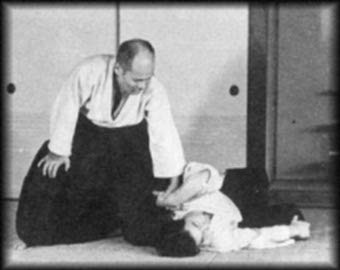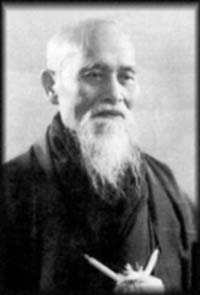






about aikido
 The
founder of Aikido, Morihei Ueshiba, was born in Japan in 1883. Since he
was a weak child, his father tried to motivate him to work out and grow
stronger by telling him stories about his granddad, one of the strongest
Samurai of his time. During master Ueshiba's youth, thugs hired by
politicians confronted to his father made his decision to grow stronger
and study martial arts even more firm. Learning fencing and Ju- jutsu
from many masters, master Ueshiba grew so strong that he became famous
for the strength of his hands. He went to school and tried to start a
business, but this wasn't enough for him. During his studies of martial
arts master Ueshiba encountered the famous master Sokaku Takeda who
taught him the art of Daito- ryu aiki ju- jutsu.
The
founder of Aikido, Morihei Ueshiba, was born in Japan in 1883. Since he
was a weak child, his father tried to motivate him to work out and grow
stronger by telling him stories about his granddad, one of the strongest
Samurai of his time. During master Ueshiba's youth, thugs hired by
politicians confronted to his father made his decision to grow stronger
and study martial arts even more firm. Learning fencing and Ju- jutsu
from many masters, master Ueshiba grew so strong that he became famous
for the strength of his hands. He went to school and tried to start a
business, but this wasn't enough for him. During his studies of martial
arts master Ueshiba encountered the famous master Sokaku Takeda who
taught him the art of Daito- ryu aiki ju- jutsu.
Sokaku Takeda was probably the last famous swordsmen of the Sword Era, which lasted well into the 19th century in Japan. This man was the last descendant of a famous Samurai family. Besides being a master swordsman, he also mastered many traditional weapons that were used on the battlefields of medieval Japan. Daito- ryu aiki ju- jutsu was an art of unarmed combat that was passed from one generation to the next in his family. When changes took place in Japan, it became clear that a swordsman, no matter how skilled and famous he may be, can not live by his sword. So, master Takeda turned to teaching Ju- jutsu.
After his father died, master Ueshiba joined a Shinto new religion, called Omoto- kyo, and embraced the ideas of pacifism and non- violence. He probably started to contemplate on the destructive nature of traditional martial arts at this time, which had defeating the enemy in the most efficient way with no regard for cruelty set as a goal. Master Ueshiba started to transform the arts he mastered into an art which would give us the possibility to defend ourselves and to preserve our foe from serious injuries at the same time. In 1942. master Ueshiba changed the name of his art from Aiki- budo (this name still contained the link to the aggressive nature of the warrior tradition) to Aikido. While the war raged in a tormented world, master Ueshiba seems to have grasped the true nature of the problem and tried to instruct humans in ways of overcoming their troubles through his short and meaningful messages:
"The art of peace is a medicine for a sick world. There is evil and disorder in the world because people have forgotten that all things emanate from one source. Return to that source and leave behind all self- centered thoughts, petty desires and anger. Those who are possessed by nothing possess everything."
"To injure an opponent is to injure yourself. To control the aggression without inflicting injury is the Art of Peace."
Before he died in 1969. master Ueshiba legated Aikido to whole mankind: "Aikido is for the entire world. Train not for selfish reasons, but for all people everywhere."
Technically, Aikido contains techniques of Ju- jutsu, fencing and Master Ueshiba's personal techniques. Besides body techniques, Aikido trainees study handling wooden sword (boken) and short pole (jo), which is essential to understanding Aikido.
Aikido is not a sport, it is a defense art. A sportsman invests his time and energy in order to gain a desired result, while a defense art trainee acquires a skill which helps him preserve emotional and mental stability, which is very important in contemporary society, improves his health and helps build relationships with other people unburdened with competitive spirit and ego. Only in extreme situations will Aikido be applied in it's original form, and even then both attacker and the defender will be preserved from serious injury. Aikido, unlike many sports, doesn't have requirements regarding the trainees health, age or sex:
 "The
Art of Peace begins with you. Work on yourself and your appointed task
in the Art of Peace. Everyone has a spirit that can be refined, a body
that can be trained in some manner, a suitable path to follow. You are
here for no other purpose than to realize your inner divinity and
manifest your innate enlightenment. Foster peace in your own life and
than apply the Art to all that you encounter."
"The
Art of Peace begins with you. Work on yourself and your appointed task
in the Art of Peace. Everyone has a spirit that can be refined, a body
that can be trained in some manner, a suitable path to follow. You are
here for no other purpose than to realize your inner divinity and
manifest your innate enlightenment. Foster peace in your own life and
than apply the Art to all that you encounter."
M. Ueshiba
